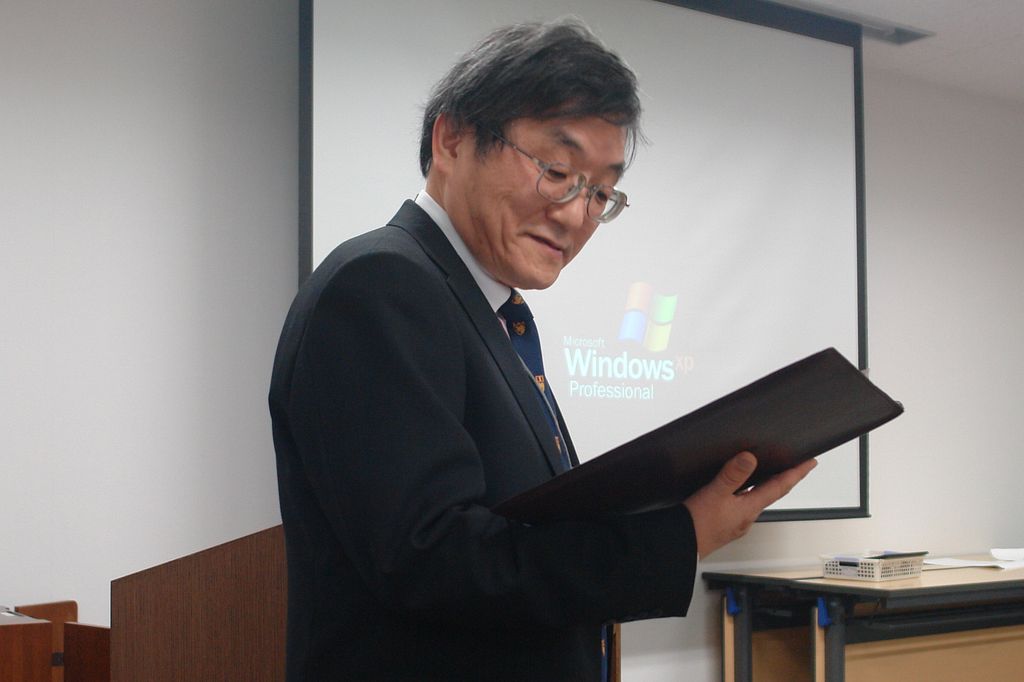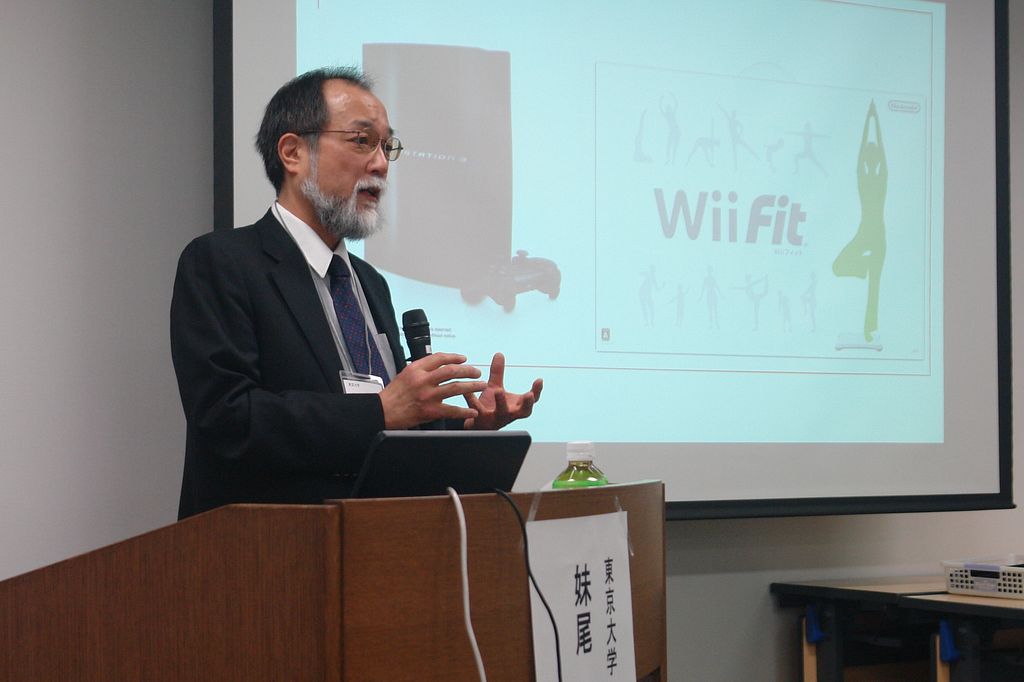2009/02/25 10:00 Ken Senoh, "Growth or Development? Improvement or Innovation? Towards the Map of Service Studies", Open Seminar on Service Systems Science, Systems Sciences Meet Service Sciences, Tokyo Institute of Technology
Open Seminar on Service Systems Science (2009), Systems Sciences Meet Service Sciences, Service Innovation Educational Program, Tokyo Institute of Technology (Tamachi campus)
This digest was created in real-time during the meeting, based on the speaker's presentation(s) and comments from the audience. The content should not be viewed as an official transcript of the meeting, but only as an interpretation by a single individual. Lapses, grammatical errors, and typing mistakes may not have been corrected. Questions about content should be directed to the originator. The digest has been made available for purposes of scholarship, posted on the Coevolving Innovation web site by David Ing.
Welcome by Kyoichi Jim Kijima

Unique perspective: systems sciences
Bridge disciplines
Agenda:
- Speakers
- Panel discussion
Ken Senoh, U. of Tokyo
- Industry-academic not-profit institute
- Systems sciences background, Ph.D. supervised by Peter Checkland in the 1980s

[Ken Senoh]
Growth of Development? Improvement or Innovation? Towards the Map of Service Studies
Kijima is senior, was a visting fellow at Lancaster in 1985
- Senoh started studies in next year
Japanese talk, starting with an apology: discrepancy from slides handed out
3 subjects:
- Innovation
- Innovative relationship between goods and services
- Pluralism of the systems science
Question: Do you want to make your enterprise grow or develop?
- Model change versus model enhancement
- Creation of new new value by new models, as compared to productivity change or enhancement
Ask this to executives, most can't tell the difference between growth and development
Model: structure, function, management
Growth == quantitative expansion of the existing model
Development == discontinuous shift to a new model
- e.g. tadpole then frog
Improvement == Continued enhancement, efficacy and efficiency --> productivity
Innovation: Need to create an epoch-making new model (creation) and make a sift from an existing model (dissemination / establishment)
Novelty and professiveness --> effectiveness
Example: Playstation and model polishment / enhancement versus Wii as a model change
Innovation: If we can have rich advanced technologies, can we win in business?
Japan has good technologies
- Intellectual property?
- International standards?
- Still don't win
Innovation models themselves are undergoing transformation: innovation model innovation
- Strength in technology is necessary, but not sufficient
History of innovation style change:
1. Individual inventor, e.g. Thomas Edison
2. Epoch-making invention-driven type of innovation by a single large company
- Principle of vertical integration, self-containment top to bottom
- e.g. Dupont, GM, Xerox, IBM
- R&D, production and sales
- If can make a epoch-making product, can push it out
- Mantra: Technological capability decides victory or defeat
3. Friendly rivalry by plural companies
- Vertical integrated of self-containment
- Large Japanese companies in 1970s and 1980s
- If we can win at home, we can win overseas as well
- Process innovation
- e.g. Toshiba, NEC, Hitachi, Fujitsu
- Win at home, then get the golden medal
4. Open innovation: 1990s to today
- Let's collaborate locally
- e.g. semiconductors, PCs, DVDs, LCD tvs
- Gradually lost market share
- e.g. Intel is unchallenged, as secure part of the finished product
- Integral inside, modular outside; or black box inside, standard outside
- Motherboard to Taiwanese makers, but almost all profits flowed back to Intel
- Those who share processes win
- First define integral whole into parts (black box), then diffusion to partners
- Large companies were good with friendly rivalry, but this strategy is finished
Learned: not just invention, but diffusion is important
Not just technnology, also business models and intellectual property
Demand open innovation model:
- 1. Shorter product life cycle
- 2. More advanced / complex technology
- 3. Rapid increase in risks due to uncertainties of the work
- Therefore open collaborative innovation
Misunderstanding of English phrase "open innovation" to Japanese people
- 1. Understanding as public offering of IP rights (with or without royalties)
- 2. In software related areas, open up source codes, e.g. Linux
- The above are only part of innovation
- 3. Diversification of resources for innovation, from perspective of universities
- Most appropriate understanding: Sharing of or collaboration in the innovation process
Then collaboration is misunderstood by Japanese
- Collaboration is usually understood as horizontal and equal, but it also works in vertical win-win relationships
- Open innovation doesn't mean full openness of technology and IP
- Just means free participation
- When Japanese get into open innovation projects, the western players are already in the cockpit
Tripartite approach
Being strong in technology is necessary, but there are two other sufficient conditions
- 1. Development of vital technology in accordance with product architectures
- 2. Construction of business models that expands markets, and profit gain
- 3. Develpoment of intellectual property protection, alternately using proprietary technology and patents, and open innovation
Infighting between business models:
- Prolonging life of an integral model versus advancement of a modular model
- Modular type vs. re-integral type
- Becoming premium versus commodity
- Finished goods (e.g. iPod) versus key part material (e.g. Intel inside)
Innovative relationship between goods and services
Monodukuri (goods making) and services
- Service industry is defined as one of two engines of growth, along with manufacturing
- Some caution required: although two engines, service and manufacturing can't be separated
Three types of relationships:
e.g. coffee and tea, coffee and sugar, coffee and cigarettes
1. Complementary relationship:
- e.g. IBM shift from manufacturing to services, 60% of revenue, and nearly 70% in Japanese
2. Substitute relationship: from owning goods to using services
- Do you want CD or to listen to the music?
3. Synergetic relationship
- iPod (goods) with iTunes (services)
- Conceive of goods as service-offering systems
Content decides victory or defeat
e.g. Asahiyama zoo, Hokkaido
- From exhibiting animal figures to exhibition of behavioiur
Pluralism of Service Sciences
Could include:
- Positivism + interpretivism, phenomenology
- Ontology + epistemology + methodology
- Quantitative + quantitative
System studies in the plural
- Originally presented in 1994, 3 types of reforms
- Systems semantics: re-orientation
- System functioning: re-engineering
- Systems dynamics: re-structuring
Approaches to plural
Conclusions:
- Service innovation, not just service science and engineering, but other points should be borne in mind
- 1. Not only experience and instinct, but also science and engineering for a synergetic effect
- 2. Not just positivism and reductionism, need to add interpretivism and phenomenology
- 3. Service science as rehashes of operations research, should be revisited not just hard approaches but also soft approaches
[Questions]

This work is licensed under a Creative Commons Attribution-NonCommercial-ShareAlike 4.0 International License